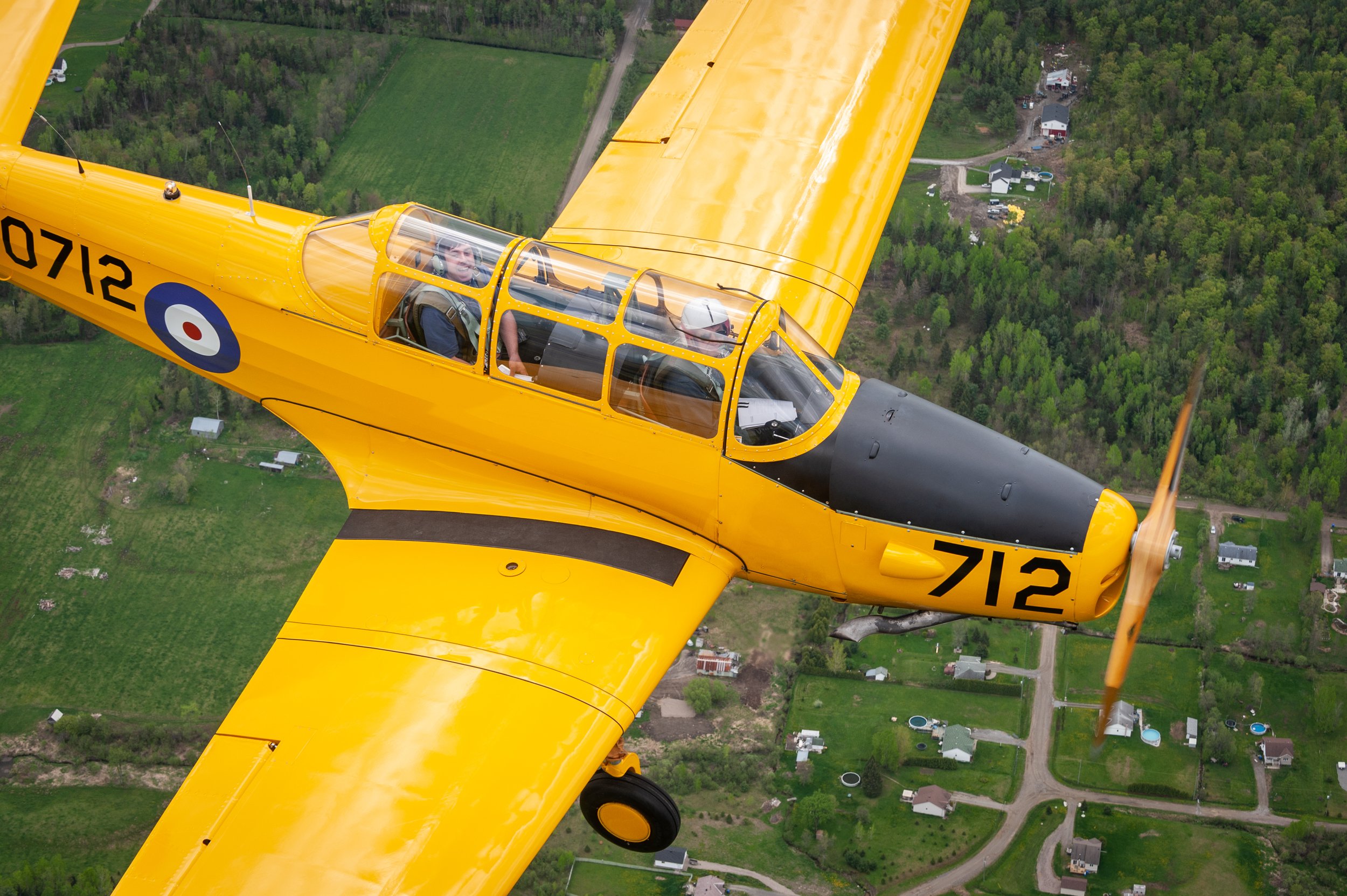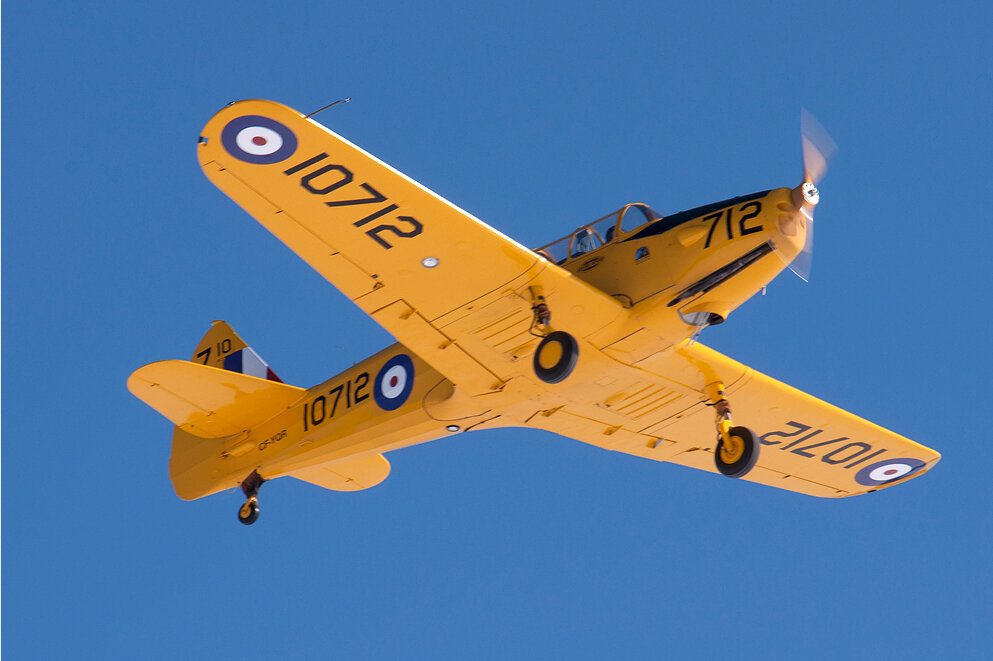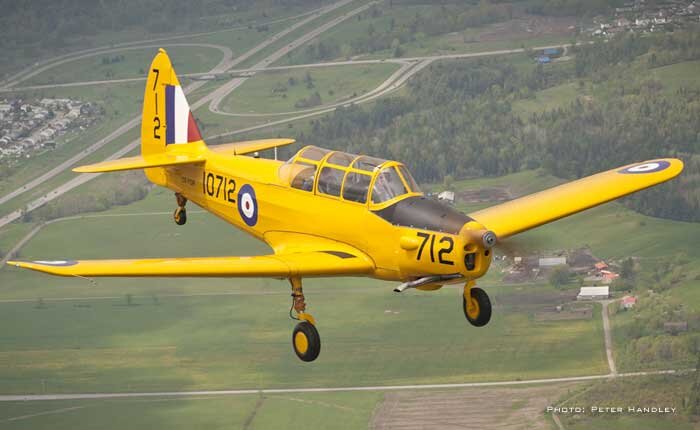
YELLOW WINGS
Celebrating 100 years of the RCAF by Inspiring the Next Generation of Aviators
The Yellow Wings program is a youth-focused effort established by Vintage Wings of Canada which takes place during the spring, summer and autumn flying seasons. This program truly reflects the mission of Vintage Wings of Canada — to Educate, Commemorate, and Inspire.
The RCAF and Yellow Wings
Partners in Inspiration
Yellow Wings uses WWII era and post-war military training aircraft as unique teaching tools which provide participants with the opportunity to immerse in a STEM-focused learning experience. As an integral part of the Royal Canadian Air Force youth outreach effort to mark the 100th anniversary of the RCAF, Yellow Wings activities will take place coast-to-coast at locations across Canada.
YELLOW WINGS PARTERS ACROSS CANADA
STEM Program
The Yellow Wings STEM program is taught by knowledgeable and dynamic volunteer aviators. During each flying season, young Canadian participants will learn about:
• the tangible value and benefits of pursuing a career in science, technology, engineering and math
• the engineering and innovative features of each aircraft, as well as get an up-close look “under-the-hood” and from the pilot’s seat in the cockpit;
• the Yellow Wings veterans’ personal stories of discipline, sacrifice and valour during past wars;
• the key role that these small, Canadian-built aircraft played in the largest aviation training program in history: the British Commonwealth Air Training Plan (BCATP).

Flight, it’s history, design and technology, has the power to inspire young people. Yellow Wings has the power to make it happen.
Yellow Wings 2024 Schedule
17, 18, 19 July — Peterborough Airport, ON
22-28 July — Gatineau-Ottawa Executive Airport: (August dates TBD)
25 July — Canada Aviation & Space Museum (Rockcliffe)
27-28 July — Miramichi-Chatham Airport, NB
29 July Canada Aviation & Space Museum (Rockcliffe)
30 July Canada Aviation & Space Museum (Rockcliffe)
31 July Canada Aviation & Space Museum (Rockcliffe)
1 August Canada Aviation & Space Museum (Rockcliffe)
7 August — Canada Aviation & Space Museum (Rockcliffe)
24 August — Windsor, ON
5 October — Windsor, ON
TBD — Arnprior, ON; Langley BC, Brandon MN and Saskatoon, SK

Register a Youth Participant for a Yellow Wings Experience
The Aerodrome of Democracy
Few Canadians know that this massive plan was responsible for training 131,500 pilots and aircrew personnel at over 200 training facilities across Canada between 1940 and 1945. Fewer yet appreciate that the BCATP remains to this day the largest infrastructure project in Canadian history.
Many thousands of Canadian youths have taken part in these educational sessions, and over 850 of the most deserving have participated in a flight aboard a Yellow Wings. These flights are meant to motivate youths and to encourage them to excel even further. The Yellow Wings program, which highlights the rich legacy of flight training in Canada, represents an ideal sponsorship and branding opportunity for corporate sponsors. Yellow Wings enjoys strong support from the Royal Canadian Air Force in delivering this valuable learning opportunity to deserving young people and the future leaders of Canada. To explore sponsorship opportunities further, please contact Vintage Wings of Canada at board@vintagewings.ca.
Fleet Finch
The Fleet Finch (Fleet Model 16) is a two-seat, tandem training biplane produced by Fleet Aircraft of Fort Erie, Ontario. There were a number of variants mainly based on engine variations. Over several years beginning in 1939, a total of 447 Finches were built, nearly all (431) of them for use as elementary trainers in the British Commonwealth Air Training Plan (BCATP) during the Second World War.
The Finch was a mainstay of the RCAF prior to and during the early part of the Second World War, flying at the Elementary Flying Training Schools (EFTS) in parallel with the better known de Havilland Tiger Moth, also produced in Canada. The earlier Fleet Model 7 (Fleet Fawn) was also in use for primary training. During 1940, initial production problems were solved and timely deliveries were made to the RCAF, allowing the first training programs to start up. In the following year, the Portuguese Navy purchased ten Model 16Ds (ordered as 10Bs but changed to the higher powered variant) and later a further five 16Ds were delivered in 1942.
A total of 606 Fleet Finches were produced as Model 16s, the majority for the RCAF. They were used as initial trainers in the BCATP at no fewer than 12 Elementary Flight Training Schools across Canada. Both the Fleet Finch and Tiger Moth were later replaced by the Fairchild PT-26 Cornell. The Finch was progressively phased out of service from October 1944 with the last of the Model 16s struck off strength from the RCAF inventory in 1947.
The Vintage Wings Finch is dedicated to Leader Hartland Ross “Hart” Finley, DFC of Montreal who learned to fly at Number 4 Elementary Flying Training School at Windsor Mills, where he actually flew the very same Finch that we now own - RCAF Serial 4462. Finley became a BCATP instructor at Summerside, PEI as well as at No. 2 SFTS here in Ottawa. He went on to fly Typhoons at his Operational Training Unit in England, but transferred to Spitfires with 403 Squadron, eventually commanding 443 Squadron. After the war, Finley continued to fly with the Department of Transport in Ottawa as the Chief VIP pilot for the federal government, flying Prime Ministers, Presidents and Royals on state visits.
Fairchild Cornell
The Vintage Wings of Canada Fairchild Cornell (10712) was built by the Fleet Aircraft Company of Canada, one of 1642 Cornells constructed under license, and they were designated either as PT-23s or PT-26s. As the Second World War advanced, the RCAF needed a more advanced trainer for the BCATP. The existing DH 82C Tiger Moths and Fleet 16B’s used for elementary flying training proved to be a significant step down from contemporary service aircraft. In the spring of 1941, the RCAF therefore decided on a development of the Fairchild Aircraft (US) Company’s PT-19 trainer design. The RCAF version was to feature an enclosed cockpit, an improved heating system, equipment changes along with a Ranger piston engine. This modified version was to be known as the Fairchild Cornell in Canada and it rapidly entered production and found favour at elementary flying schools beginning in 1943.
Cornell 10712 was one of five bought from war surplus at Windsor Mills, Quebec by Paul Durand and his eldest son Bob in 1955. The price paid by the Durands that day ranged from $150.00 to $300.00.
The Vintage Wings of Canada Cornell is dedicated to Royal Air Force Flight Lieutenant Archie Pennie, an elementary flying instructor on Cornells during the Second World War. As part of the British Commonwealth Air Training Plan, Archie Pennie instructed RAF pilots on Cornells at No. 34 EFTS, Assiniboia, Saskatchewan for two years, and has nearly 650 hours instructing on the type. Archie went on to fly Bristol Blenheims and de Havilland Mosquitoes at the very end of the war.
Canadian Car and Foundry Harvard 4
The Harvard is recognized as the greatest advanced training aircraft of the war. With its near fighter-like size and handling, the Harvard was the bridge between primary trainers such as the Tiger Moth and the high performance fighters of the day such as the Spitfire or Hurricane. Nearly 50,000 Allied pilots received their wings after qualifying on the Harvard at air training bases across the breadth of Canada as part of the British Commonwealth Air Training Plan (BCATP) - the “Aerodrome of Democracy”. Somewhat forgiving to fly, the Harvard was an able trainer, but had just enough quirks and vices to keep students on their toes.
The High Flight Harvard is painted in the unique markings of a Harvard known to have been flown by Anglo-American Pilot Officer John Gillespie Magee when he was in Service Flying Training at No. 2 SFTS Uplands in Ottawa. Magee is the iconic poet who penned High Flight, the iconic poem about flight in a heavier than air craft. High Flight is a requested reading at many an aviator's funeral and was read by President Ronald Reagan at the memorial for the crew of the Challenger Shuttle disaster.
de Havilland Canada Chipmunk
The de Havilland Canada DHC-1 Chipmunk is a tandem, two-seat, single-engined primary trainer aircraft designed and developed by Canadian aircraft manufacturer de Havilland Canada. It was developed shortly after the Second World War and sold in large numbers during the immediate post-war years, being typically employed as a replacement for the de Havilland Tiger Moth biplane.The Chipmunk was the first postwar aviation project conducted by de Havilland Canada. It performed its maiden flight on 22 May 1946 and was introduced to operational service that same year. During the late 1940s and 1950s, the Chipmunk was procured in large numbers by military air services such as the Royal Canadian Air Force (RCAF), Royal Air Force (RAF), and several other nations' air forces, where it was often utilised as their standard primary trainer aircraft. The type produced under licence by de Havilland in the United Kingdom, who would produce the vast majority of Chipmunks, as well as by OGMA (Oficinas Gerais de Material Aeronáutico) in Portugal.
Many Chipmunks that had been in military use were sold to civilians, either to private owners or to companies, where they were typically used for a variety of purposes, often involving the type's excellent flying characteristics and its capability for aerobatic manoeuvres. More than 70 years after the type having first entered service, hundreds of Chipmunks remain airworthy and are in operation around the world.
de Havilland Canada DCH-1 Chipmunk, RCAF Serial No. 18025, is dedicated to Russell William Bannock, OOnt., DSO, DFC and Bar and legend in Canadian aviation and a member of Canada’s Aviation Hall of Fame. Bannock, the Royal Canadian Air Force’s second highest-scoring ace in the Second World War, slipped the surly bonds of earth on January 4, 2020, at the age of 100. In honour of Wing Commander Bannock, who had a distinguished career with de Havilland Aircraft and other civilian aviation organizations following the war, we dedicate this Chipmunk in his name. Recently, the Arnprior/South Renfrew Municipal Airport near Ottawa was renamed The Russ Bannock Airport. During the Second World War, the airport hosted No. 3 Flying Instructor School for the British Commonwealth Air Training Plan. Russ was also an instructor there, where he taught newly winged pilots to become flying instructors.










